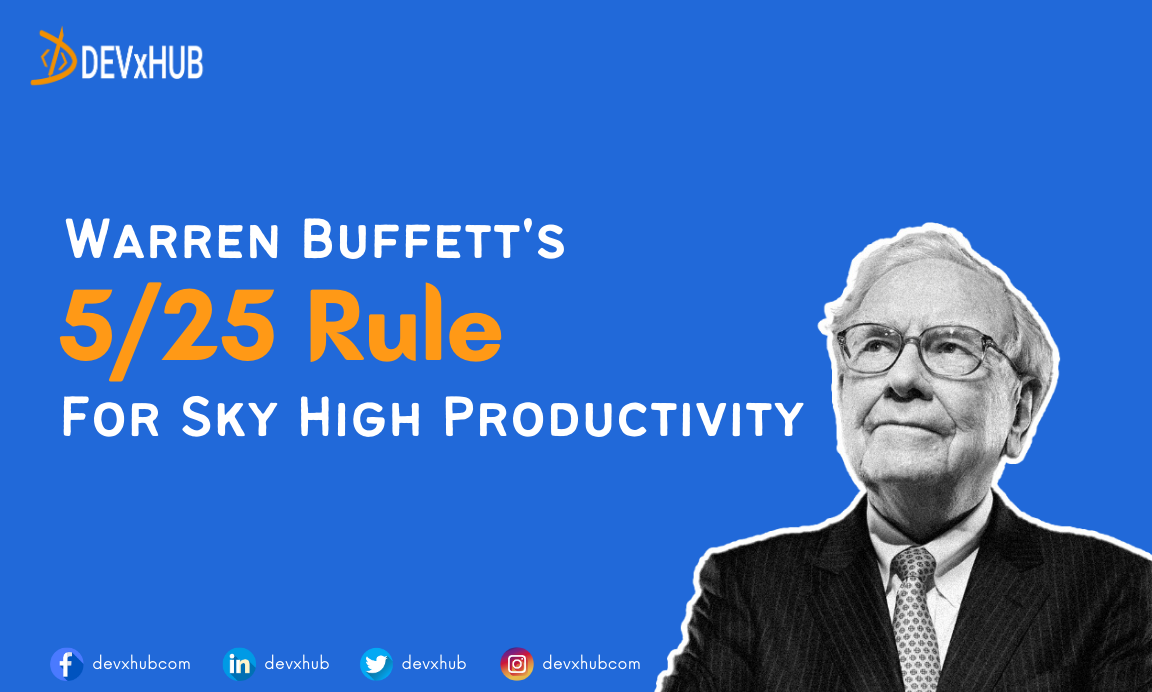Blog - Warren Buffett's 5/25 Rule For Sky High Productivity
Warren Buffett’s 5/25 Rule
The philosophy of the rule is deceptively simple. Start with a broad range of 25 goals, aspirations, and dreams. These goals can span across various domains of your life – career, personal growth, relationships, health, or financial prosperity. It’s key to ensure that these goals are significant and resonate profoundly with your life vision.
After archiving your top 25 goals, it’s time to narrow these down to the top five. These are the goals that matter the most to you. The process can be challenging, as it requires self-awareness, introspection, and sometimes, brutal honesty with oneself. However, it’s this process of selection that sets the course for achieving high productivity.
Once your top five goals are identified, the operative philosophy is straight forward: focus almost exclusively on these five top targets and put the other 20 on hold. Dedicate your time, energy, resources, and attention to achieving these five goals.
Per Warren Buffett’s advice, the remaining 20 goals become your “avoid at all costs” list until you’ve achieved your top five. This might seem counterintuitive and even difficult. They are, after all, goals that you’re interested in, but they are distractions taking away from the important five. Giving any attention to the rest of the 20 goals could compromise your commitment to succeeding in the five that matter the most.
The Genesis of the 5/25 Rule
The rule’s origin is reported as advice given by Buffet to his personal pilot, Mike Flint. Flint asked Buffet for career advice, leading to Buffet thinking of the 5/25 rule. Buffet asked Flint to list his top 25 career goals, pick the top five, and avoid the rest until the top five are achieved.
How is Warren Buffet’s 5/25 rule helpful?
The 5/25 rule is an exercise used to help people truly focus on the most valued accomplishments that are most meaningful to them.
Even though it’s most used for career accomplishments, the 5/25 rule can be applied to both personal or professional goals, family time, or career aspirations, making it an effective, simple technique for prioritizing all aspects of life.
However, making lists of goals is something that most people already do. In fact, it’s the typical first step in countless goal-setting methods.
The truth is, it’s Buffett’s way of prioritization that makes this rule so unique: selective focus. Buffet’s 5/25 rule is precisely how you prioritize your list of goals the Warren Buffet way.
Focus solely on fully committing to smaller goals to complete them more effectively, instead of juggling all your goals at once.
At first, this kind of sounds weird, right? But the truth is we’re constantly used to assuming that doing more is better, in terms of speed and quality, even though we deep down know that’s not true.
Efficacy of the 5/25 Rule
The 5/25 rule’s strength lies with the minimalist mindset it promotes. By accepting that we can’t focus on a multitude of things at once, it pares down our objectives to a smaller set. This smaller, more focused set makes for a high chance of achieving them successfully.
It’s easy to fall into a trap of wanting to do too many things simultaneously. The 5/25 rule forces a clear commitment to a select few goals, thus conserving energy for more focused endeavors.
Why is Warren Buffet’s rule important?
The truth is that the limited time and energy we have to accomplish our daily tasks is one of the major causes of workload and job stress. Why is that, then?
Perhaps we have a little too much ambition and try to accomplish too many things at once. As a result, we fail to devote the necessary time and effort to achieving the broader objectives we set for ourselves.
As a result, we easily become exhausted, sidetracked, and lose focus, failing to realize our goals and complete the tasks that are truly important to us.
Because there are so many objectives vying for your attention, how can you find a way to prioritize and concentrate? That is the basic idea behind Buffet’s rule.
Warren Buffett claims that his straightforward three-step technique will help you focus on your most crucial goals first and make steady progress in your life.
Applying the 5/25 Rule to Life and Career
The rule is versatile and can be applied to all facets of life, but shines when used specifically for career planning. With countless potential objectives and accomplishments over a career’s timeline, sticking to the 5/25 rule keeps one grounded and focused.
To implement it effectively in your career, here is a simple process:
- Document your top 25 career goals: This can include mastering new skills, achieving specific roles, or even starting your own enterprise.
- Identify five primary goals: These should be relatively impactful and meaningful to your career progression.
- Devote yourself to achieving these 5 goals: This often means disregarding or postponing other goals to give these five your full energy and time.
How To Get 5/25 Focus: 6 Tips
Few people achieve the level of success that Warren Buffett accomplishes, in part because of the unwavering commitment and tenacity required by his business philosophies. Without solid and healthy working habits, you will fail in the ongoing war against procrastination and distraction.
If you’re considering using the 5/25 rule, it wouldn’t hurt to sharpen your focus.
There are many strategies to be more productive, but we won’t go into them all here. Organize your thoughts and focus on your objectives:
1) Have a clear purpose for why you are doing something. (e.g. assess the reason for every action you’ve planned in a daily schedule)
2) Eliminate distractions and minimize interruptions
3) Be organized and have an efficient system in place (e.g. use an online planner, not a paper calendar)
4) Use selective focus to follow your priorities (e.g. don’t multi-task, but single-task instead!)
5) Prolonged focus is draining, so take regular breaks to refresh (e.g. take a walk, get some fresh air, step away from the screen)
6) Buffett calls it an “Avoid-At-All-Cost list” for good reason – don’t waste time worrying about things outside the top 5 (e.g. if an opportunity to work on another goal presents itself, resist and stick to your set 5 priorities)
Final Thoughts on the 5/25 Rule
Making tough decisions is apparently commonplace in the era of Warren Buffett, who has arguably the best investment track record ever. His professional journey began with three shares of Cities Service Preferred at a price of $38 per share and continued through his record $139 billion investment in Apple. It’s no accident that just a small number of Buffet’s holdings account for the majority of his stock value.
This man has undoubtedly lived up to the advice he gave to pilot Mike Flint all those years ago.
His carefully chosen choices demonstrate that he has clear goals and will concentrate on the profitable few rather than the disorienting majority. It really is the same thing when it comes to making goals. You’ll soon see some good profits if you invest in your top 5 and ignore the rest!
The underlying philosophy of the 5/25 rule is about saying ‘No’. Buffett’s advice is often quoted as, “The difference between successful people and really successful people is that really successful people say no to almost everything.”
In conclusion, the application of Warren Buffett’s 5/25 rule can sharply enhance productivity and focus. By forcing priority designation among a list of desired goals, one creates a norms-managing system to efficiently sail towards one’s ambitious destinations.
Related Posts
Categories
- App Development (2)
- Design (2)
- DEVxHUB (30)
- Digital Marketing (2)
- Guide (24)
- It Bangladesh (1)
- Logo design (1)
- Operating system (1)
- Personal Improvement (14)
- Planning (4)
- Project management (3)
- Social media (2)
- Software Development (5)
- Software Quality Assurance (8)
- Startups (1)
- Team work (1)
- UI UX (1)
- Web Development (6)
Main Tags
- 2024
- Android
- app development
- bangladesh
- content writing
- design
- devxhub
- Digital marketing
- Guide
- IOS
- It
- logo design
- Operating system
- Personal Improvement
- planning
- project management
- social media
- Software Development
- Software Quality Assurance
- software testing
- software testing types
- Startups
- Success
- team
- UI UX
- UI UX design
- VR
- Web Development















